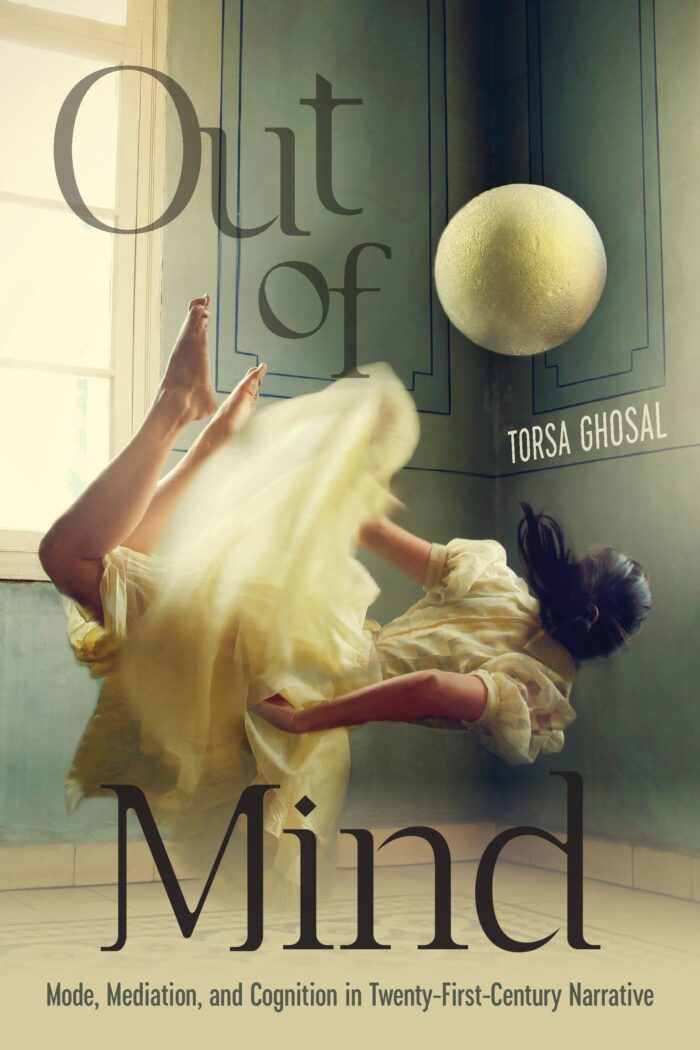
Book | Out of Mind: Mode, Mediation, and Cognition in Twenty-First-Century Narrative
Subjects: anglophone literature, narrative theory, multimodality studies, cognitive sciences, and disability studies
Buy from The Ohio State University Press, Bookshop, Amazon
What is the relationship between aesthetic presentation of thought and scientific conceptions of cognition? Out of Mind: Mode, Mediation, and Cognition in Twenty-First-Century Narrative answers this question by offering incisive commentary on a range of contemporary fictions that combine language, maps, photographs, and other images to portray thought. Situating literature within groundbreaking debates on memory, perception, abstraction, and computation, the book shows how stories not only reflect historical beliefs about how minds work but also participate in their reappraisal.
“Torsa Ghosal’s Out of Mind urges us to be more open-minded (pun intended) and embrace explanatory pluralism for how minds work.”
Sue J. Kim, author of On Anger: Race, Cognition, Narrative
As cognitive literary studies moves more adeptly across narrative media, Torsa Ghosal’s Out of Mind admirably takes media-conscious, multimodal fictions into the fold, exploring the ways in which narrative fiction culturally and historically encodes what we think we are doing when we perceive, map, remember, and forget our own lived experiences.”
David Ciccoricco, author of Reading Network Fiction
Order from The Ohio State University Press to get 30% off on the hardback with the code ‘GHOSAL’ (case-sensitive) and free shipping within the US.
EDITED VOLUMES

Fictionality and Multimodal Narratives interrogates the multimodal relationship between fictionality and factuality. The contemporary discussion about fictionality coincides with an increase in anxiety regarding the categories of fact and fiction in popular culture and global media. Today’s media-saturated historical moment and political climate give a sense of urgency to the concept of fictionality, distinct from fiction, specifically in relation to modes and media of discourse.
Torsa Ghosal and Alison Gibbons explicitly interrogate the relationship of fictionality with multimodal strategies of narrative construction in the present media ecology. Contributors consider the ways narrative structures, their reception, and their theoretical frameworks in narratology are influenced and changed by media composition—particularly new media. By accounting for the relationship of multimodal composition with the ontological complexity of narrative worlds, Fictionality and Multimodal Narratives fills a critical gap in contemporary narratology—the discipline that has, to date, contributed most to the conceptualization of fictionality.

Global Perspectives on Digital Literature: A Critical Introduction for the Twenty-First Century explores how digital literary forms shape and are shaped by aesthetic and political exchanges happening across languages and nations. The book understands “global” as a mode of comparative thinking and argues for considering various forms of digital literature―the popular, the avant-garde, and the participatory―as realizing and producing global thought in the twenty-first century. Attending to issues of both political and aesthetic representation, the book includes a diverse group of contributors and a wide-ranging corpus of texts, composed in a variety of languages and regions, including East and South Asia, parts of Europe, Latin America, North America, Australia, and Western Africa. The book’s contributors adopt an array of interpretive approaches to make visible new connections and possibilities engendered by cross-cultural encounters. Among other topics, they reflect on the shifting conditions for production and distribution of literature, participatory cultures and technological affordances of Web 2.0, the ever-changing dynamics of global and local forces, and fundamental questions, such as, “What do we mean when we talk about literature today?” and “What is the future of literature?”
Select academic articles
published academic articles can be read at https://osu.academia.edu/TorsaGhosal
Articles in Peer-Reviewed Journals
- “Shapes of Cognition in Typographical Fictions” in Studies in the Novel 51.2 (Summer 2019)
- “At Hand—Handwriting as a Device for Spatial Orientation in J.J. Abrams and Doug Dorst’s S.” in Poetics Today 40.2 (Summer 2019), Special issue on Multimodal Media.
- “Books with Bodies: Narrative Progression in Books with Bodies Illustrated with Chris Ware’s Building Stories” in Storyworlds: A Journal of Narrative Studies (Spring 2015)
- “Strikethrough Calcutta: Poetics and Politics of Interruption in Satyajit Ray’s and Mrinal Sen’s Calcutta Trilogies” in South Asian Review (Spring 2015)
- “Unprojections: Worlds under Erasure in Contemporary Hollywood Films” in Media-N: Journal of the New Media Caucus (Spring 2015).
- “A World of Sin,” co-authored with Christopher Gonzalez and Frederick Luis Aldama, in Post Script 33.3 (Summer 2014)
Book Chapters
- “Towards Narrative AI Studies.” The Routledge Handbook of AI and Literature, edited by Will Slocombe and Genevieve Lively. (Routledge, UK, 2024).
- “Dancing Feeling, Kinesthetic Empathy in Contemporary Dance Fictions.” The Routledge Companion to Literature and Art (Routledge, 2024).
- “Forgetting at the Intersection of Comics and the Multimodal Novel: James Sie’s Still Life Las Vegas” in The Oxford Handbook of Comic Book Studies (Oxford University Press, 2019)
- “The Page is Local: Planetarity and Embodied Metaphor in Anglophone Graphic Narratives from South Asia” in Comics Studies Here and Now (Routledge, 2018).
- “Baar Baar Sakhi: Queer Temporalities of Sakhya in Performance,” co-authored with Kaustavi Sarkar, in Friendship as Social Justice Activism (U of Chicago P and Seagull, 2018).
- “Empathic Cross-Fires: Latinos in Bollywood…Bollywood in Latinolandia” in Latinos and Narrative Media (Palgrave MacMillan, 2013)
Discussion and Dictionary Entries
- “How do the visual-tactile elements of page design contribute to the way image-texts sound?” in The Middle Space’s Seeing Sounds/Hearing Pictures–A Round Table on Sound and Comics.
- “Interactive Fiction, Unnatural” in the Dictionary of Unnatural Narratology, published by the Narrative Research Lab at Aarhus University, Denmark
Book Reviews
- Review of White Literary Taste Production in Contemporary Book Culture – Alexandra Dane and Reading Bestsellers: Recommendation Culture and the Multimodal Reader – Danielle Fuller and DeNel Rehberg Sedo. Wasafiri 117.
- “On the Significance of Digital Epitexts (Review essay).” DIEGESIS 13.1
- Review of Malik Sajad’s Munnu: a boy from Kashmir (comics), in South Asian Popular Culture (Autumn 2016)